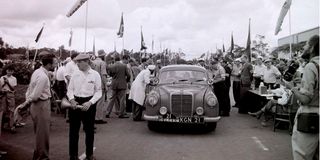Mercedes on a hat trick as timing to the last second is introduced

The winning Mercedes-Benz 219 of W. A. “Bill” Fritschy and Jack Ellis (start number 21) during the East African Safari Rally in1960.
What you need to know:
- Works teams would be coming in droves on their own terms. Nowicki finished fifth overall as he laid his foundation for future events.
Mercedes were going for a hat-trick of Safari Rally wins in 1961, a goal they achieved with remarkable ease.
John Manussis, in a Mercedes-Benz 220SE, beat defending champion Bill Fritschy, who had won in 1959 and 1960 driving a Mercedes-Benz 2019 by a mere six minutes after 5,364km of a rally characterised by hazards like rocks and ruts hidden by fesh fesh dust on the floor of the Rift Valley.
Overtaking was a problem because of the dust. The bigger cars had an as because they could achieve higher speeds in open stretches.
Timing to the last second was introduced in competitive stages but one could still be penalised if he was faster or slower than the permitted speed on open roads.
This rally was about finding a balance between endurance and speed. Manussis was a circuit racer at Langa Langa while Fritschy was a long-distance runner looking for a hat trick of wins in a Mercedes 220SE, a similar car to Manussis, prepared locally and entered by D.T. Dobie.
Ship cars
Ford and Renault chose to ship factory-prepared cars from their mother companies, driven by European professionals. Ford and Rootes chose local talent and technical know-how of East African mechanics.
Peugeot entered Nicki Nowicki and Paddy Cliff. They were relying on local knowledge and development tests done throughout East Africa by this 404 workhorse.
Women too were present to claim a portion of glory and were by no means slower as Anne Hall and Lucille Cardwell finished a laudable third overall in a Ford Zephyr.
Hall was the best-placed overseas drive after finishing third. Her performance as a lady only increased the desire for foreign drivers to always return to Kenya.
It was a straight fight right from the beginning between Manussis and Fritschy as the cars left for Tanganyika where they encountered heavy rains that affected everybody including the leaders who incurred penalties on road sections.
They returned to Kenya almost unchallenged and by the team the competition was hitting Eldama Ravine area it was no longer in doubt that the two competing Mercedes vehicles would romp home one, two unchallenged.
Ace up his sleeve
Manussis had an ace up his sleeve. While Fritschy opted for Kim Mandeville for the navigational job, Manussis teamed up with other friends, B. Coleridge and D. Becket to assist each other.
Again this paid off and was practised by other crews before the rules were changed to have only one co-driver.
Hall and Cardwell were awarded the “Coupe des Dames” trophy and continued to attract attention in East Africa and the rest of the world.
But as the organisers prepared for the 1962 East African Safari Rally, they were aware that they would no longer claim ownership.
Works teams would be coming in droves on their own terms. Nowicki finished fifth overall as he laid his foundation for future events.




